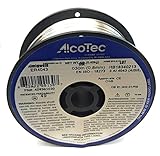Quick Look
YESWELDER’s BWX-01 110 V rod oven protects stick electrodes from moisture pickup — a common cause of porosity and hydrogen cracking. With a 15 lb capacity and adjustable thermostat, it’s built for portable field work and shop maintenance alike.
Key Takeaways
- Voltage: 110 V AC power
- Temperature range: 85 °F – 300 °F adjustable
- Capacity: Holds up to 15 lb of 15-in. or shorter rods
- Weight: Under 8 lb (portable aluminum housing)
- Purpose: Keeps low-hydrogen and general electrodes moisture-free
Performance and Use
The BWX-01 maintains a steady internal temperature to prevent flux moisture absorption — critical for E7018 and other low-hydrogen rods. Its insulated canister warms evenly, reducing hydrogen-induced cracking and maintaining clean arc starts. The light weight and side handle make it easy to move between stations or field sites.
Ideal for welding schools, fabrication shops, and on-site pipe or structural crews needing reliable storage between weld passes.
In-Box / Not Included
Included:
- BWX-01 rod oven
- Power cord (110 V plug)
- Adjustable temperature control
Not Included:
- Rods/electrodes
- Extension cord
Applications
- Stick welding rod storage (E7018, E6010, E6011, etc.)
- Shop and field maintenance
- Moisture control before critical code welds
Comparison Table
| Model | Capacity / Temp Range | Best For | Amazon |
|---|---|---|---|
| YESWELDER BWX-01 | 15 lb • 85–300 °F • 110 V | Portable rod storage | See on Amazon |
Safety Notes
Follow AWS A5.1 and A5.5 storage guidelines for low-hydrogen electrodes. Keep oven on a stable, dry surface and disconnect power before moving. Do not exceed 300 °F to prevent flux degradation.
FAQ
Q: Can it handle 7018 rods?
Yes — that’s its main purpose. It maintains low hydrogen levels for 7018 and similar electrodes.
Q: Is the temperature controlled automatically?
It’s manual via dial control, allowing fine adjustment between 85 °F – 300 °F.
Q: How many rods fit inside?
Roughly 10-15 lb depending on diameter and length (up to 15 in.).
- Moisture Protection: Used to prevent moisture from contaminating your welding electrodes to maintain low hydrogen weld deposit properties and ensuring strong, crack-free welds
- Portable Design: Weighing under 8 pounds with handle, this rod oven is easy to carry and transport. It seamlessly adapts to various work environments—from workshops and garages to outdoor sites—providing dry electrodes whenever and wherever needed
- Large Capacity: Designed to hold up to 15 pounds of rods (14 inches or shorter), it can store enough electrodes to support continuous welding for several hours or even a full day. The wide-opening lid and easy-grip handle allow for effortless access to rods, even while wearing gloves
- Adjustable Temperature: A user-friendly knob enables precise temperature control from 85°F to 300°F, meeting the drying requirements of different electrode types
- Note: Designed to maintain electrode dryness. To ensure safety, avoid extended unattended use (e.g., over 8 hours or overnight)
Last update on 2025-12-06 / Affiliate links / Images from Amazon Product Advertising API
Where to Buy
Amazon: YESWELDER BWX-01 15 lb Portable Welding Rod Oven
We may earn a commission on purchases made through our links, at no extra cost to you.




![ARCCAPTAIN iControl [Non-HF] Plasma Cutter CUT55 MP with APP Control, 55Amp Blowback Pilot Arc, 120V/240V, Upgraded LED Display, Expanded Metal, Rust Removal, Plasma Gouging, Pressure Detection](https://m.media-amazon.com/images/I/51hLye1tq1L._SL160_.jpg)










